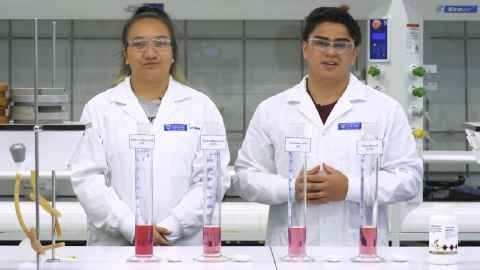Online learning helps high school students pursue STEM pathways
12 September 2023
An online learning resource is helping Kiwi secondary school students get up to speed in STEM subjects.

STEM Online NZ is a free interactive teaching and learning resource for NCEA external standards in STEM (Science, Technology, Engineering, Mathematics) subjects. The platform, developed by the University of Auckland, provides additional support to schools to address the falling uptake of students taking STEM-related subjects in senior secondary school.
The programme has already been used by more than 15,000 students in 143 secondary schools across the country, and now, thanks to an additional funding boost, it’s set to be expanded even further. The programme will be extended to include both internally and externally assessed standards, as well as changes to the NCEA standards set to be introduced by the Ministry of Education from 2024 to 2026.
Emeritus Professor Graeme Aitken, who has been the academic leader of STEM Online NZ since its inception in 2016, says the programme aims to combat the shortage of subject-specialist teachers in physics, chemistry and mathematics in secondary schools around Aotearoa and to address inequities of access to learning resources.
“Physics, chemistry and mathematics success at senior secondary school opens pathways to careers in medical and engineering fields that are critical for New Zealand,” he says. “The shortage of specialist teachers in these subjects, and the particular shortage in low-decile schools, compromises the ability of students, and especially Māori and Pacific students, to pursue these pathways.”
The programme was initially established with funding from the German philanthropist Dr Beate Schuler. Beate and the Woolf Fisher Trust recently contributed a combined $2.2 million to fund the expansion of the programme.
Graeme says he is enormously grateful for the support of Beate and the Woolf Fisher Trust.
“Donor support is critical because it enables the University to draw on its unique range of staff and student expertise, and technologies, to make physics, chemistry and mathematics appealing for all students, and especially for those from less well-resourced schools. The donor funding removes one of the most significant barriers to entry to the medical and engineering professions by making available at no cost resources that support success in the absence of specialist teachers.”
Feedback from teachers and students who have used the platform, collected via surveys and subsequently anonymised, has so far been positive, with educators saying it is something extra to add to their “kete of knowledge”.
“It has been very, very useful for new students,” one teacher said. “We are a high immigrant area, so we have a high number of students who have not been in the country for very long. These resources have been a great tool to catch them up if they have come part way through the year, or if they have not taken science before.”
One physics teacher said they were especially impressed by the way difficult concepts are explained in an easy-to-understand way.
“The short videos explain the key concepts so brilliantly. I have just worked through the level 2 Electrical Circuits and I love it! When I was at school (many moons ago) I figured out how to get the right answers, but I never felt that I really understood it. Now I do – at last!”
The online content is presented by University of Auckland students, something that has also proven to be popular.
“It looks different to other online learning tools I have used,” one secondary school student commented. “I like that it has videos to explain the math by uni students. I look forward to using it as an extra option in preparation for my upcoming exam.”
Media contact
Helen Borne | Communications Manager
Alumni Relations and Development
Email: h.borne@auckland.ac.nz